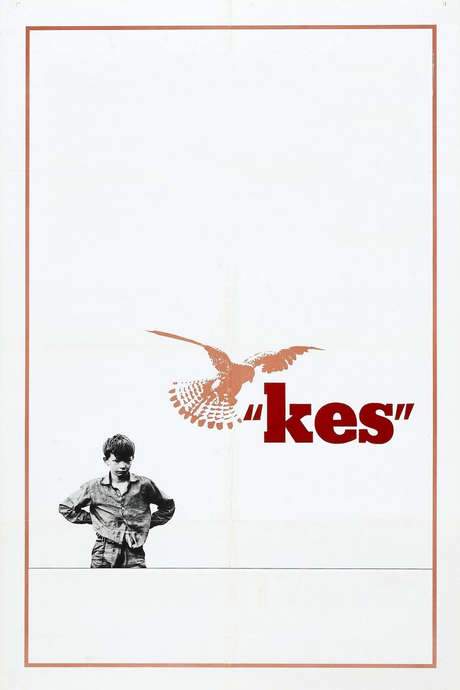
Kes
Year: 1969
Runtime: 111 mins
Language: English
Director: Ken Loach
Subjected to relentless bullying at school and neglect at home from an indifferent mother and hostile older brother, 15‑year‑old Billy Casper, a working‑class Yorkshire boy, finds solace in a wounded kestrel he names Kes. With encouragement from his English teacher and classmates, Billy learns to train the bird, discovering purpose and a renewed spirit that transcends his harsh surroundings.
Warning: spoilers below!
Haven’t seen Kes yet? This summary contains major spoilers. Bookmark the page, watch the movie, and come back for the full breakdown. If you're ready, scroll on and relive the story!
Kes (1969) – Full Plot Summary & Ending Explained
Read the complete plot breakdown of Kes (1969), including all key story events, major twists, and the ending explained in detail. Discover what really happened—and what it all means.
Fifteen-year-old Billy Casper grows up in a late-1960s South Yorkshire town where the coal mining industry casts a long shadow over everyday life. He faces constant pressure at home from his older half-brother, a mine worker, and endures taunts and rough treatment at school from peers and some teachers. With his father long gone, his mother speaks of their prospects in a hushed, hopeful tone at times, but more often she frames their situation as a difficult reality, a “hopeless case” that seems hard to escape. Billy is marked as someone who will soon leave school as an “Easter Leaver”, without public examinations or qualifications, and he isn’t sure what kind of work might wait for him—indeed, Jud hints he may end up down the mine with him, while Billy himself resists that fate.
One day, Billy’s life takes a small but meaningful turn when he enters a farm yard and takes a kestrel, nicknamed Kes, from a nest. His curiosity about falconry grows into a real project as he borrows books on training the bird from a secondhand shop and tries to obtain library access against the odds of his age. As Kes becomes a companion and a channel for his ambitions, Billy’s outlook shifts: he begins to taste a sense of purpose and competence that has been missing for a long time. This spark earns him a rare moment of praise from his English teacher after he gives an spontaneous talk about training Kes, a moment that stands out as a rare highlight in his rough-and-tumble world.
Meanwhile, Jud’s world remains harsh and practical. He gives Billy money and instructions to place a bet on two horses, but after consulting a fellow punter who doubts the odds, Billy ends up spending the money on fish and chips with the intention of buying meat for Kes. The unexpected win of the horses leaves Jud furious and feeling betrayed, and he retaliates in a cruel, final act by releasing Kes into the wild. Yet the bird’s loyalty and desperation drive it back toward Jud; the moment ends with the kestrel’s claws slashing toward him, and Jud, in a brutal act, kills the bird. Grief-stricken, Billy retrieves the bird’s broken body from a waste bin and brings it to the attention of Jud and his mother, a quiet, painful confrontation that lays bare the fragility of hope in the face of loss.
In the aftermath, Billy and his family collide with the hard truths of their environment. The bird’s death becomes a catalyst that seals the emotional distance between Billy and the adults around him, while reinforcing his own longing for something more than a life mapped by mine work and daily struggle. The hillside above the fields, where Billy had once flown Kes, becomes a quiet setting for reckoning and memory. The story lingers on the tension between aspiration and adversity, showing how a young boy can find a brief, bright spark in a forbidden kind of friendship and skill, even as the larger forces of poverty, family strain, and social neglect threaten to snuff it out.
Throughout, the film portrays Billy with a careful, observant eye, balancing moments of tenderness and resilience with the unflinching toughness of working-class life. The bond with Kes is portrayed as a meaningful escape, a doorway to responsibility, patience, and a broader sense of possibility. The narrative remains grounded in realism, yet it allows glimpses of beauty and personal growth to shine through the otherwise stark landscape.
Last Updated: October 09, 2025 at 10:43
Unlock the Full Story of Kes
Don't stop at just watching — explore Kes in full detail. From the complete plot summary and scene-by-scene timeline to character breakdowns, thematic analysis, and a deep dive into the ending — every page helps you truly understand what Kes is all about. Plus, discover what's next after the movie.
Kes Timeline
Track the full timeline of Kes with every major event arranged chronologically. Perfect for decoding non-linear storytelling, flashbacks, or parallel narratives with a clear scene-by-scene breakdown.



